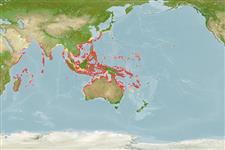Actinopterygii (ray-finned fishes) >
Perciformes (Perch-likes) >
Carangidae (Jacks and pompanos) > Caranginae
Etymology: Selaroides: A Malay vernacular name, ikan selar + Greek, suffix, oides = similar to.
Environment / Climate / Range
Ecology
Marine; brackish; reef-associated; amphidromous (Ref. 51243); depth range 1 - 50 m (Ref. 90102). Tropical, preferred 28°C (Ref. 107945); 39°N - 34°S, 49°E - 170°E (Ref. 54888)
Indo-West Pacific: Persian Gulf to the Philippines, north to Japan, south to the Arafura Sea (Ref. 9819) and Australia (Ref. 3287).
Length at first maturity / Size / Weight / Age
Maturity: Lm 11.9, range 9 - 11 cm
Max length : 22.0 cm TL male/unsexed; (Ref. 28620); common length : 15.0 cm TL male/unsexed; (Ref. 9137); max. published weight: 625.00 g (Ref. 4883)
Adults occur in inshore waters of the continental shelf (Ref. 7300). They form large demersal schools over soft bottom habitats at depths shallower than 50 m. Sometimes they ascend into freshwater reaches like the freshwater tidal zone in the Mekong delta (Ref. 12693). Ostracods, gastropods and euphausiids are common prey but small fish are also taken.
Life cycle and mating behavior
Maturity | Reproduction | Spawning | Eggs | Fecundity | Larvae
Paxton, J.R., D.F. Hoese, G.R. Allen and J.E. Hanley, 1989. Pisces. Petromyzontidae to Carangidae. Zoological Catalogue of Australia, Vol. 7. Australian Government Publishing Service, Canberra, 665 p. (Ref. 7300)
IUCN Red List Status (Ref. 115185)
CITES (Ref. 94142)
Not Evaluated
Threat to humans
Harmless
Human uses
Fisheries: commercial
Tools
Special reports
Download XML
Internet sources
Estimates of some properties based on models
Phylogenetic diversity index (Ref.
82805): PD
50 = 1.0000 [Uniqueness, from 0.5 = low to 2.0 = high].
Bayesian length-weight: a=0.01349 (0.01198 - 0.01519), b=2.96 (2.93 - 2.99), in cm Total Length, based on LWR estimates for this species (Ref.
93245).
Trophic Level (Ref.
69278): 3.8 ±0.2 se; Based on diet studies.
Resilience (Ref.
69278): High, minimum population doubling time less than 15 months (K=0.5-1.3).
Vulnerability (Ref.
59153): Low vulnerability (13 of 100) .
